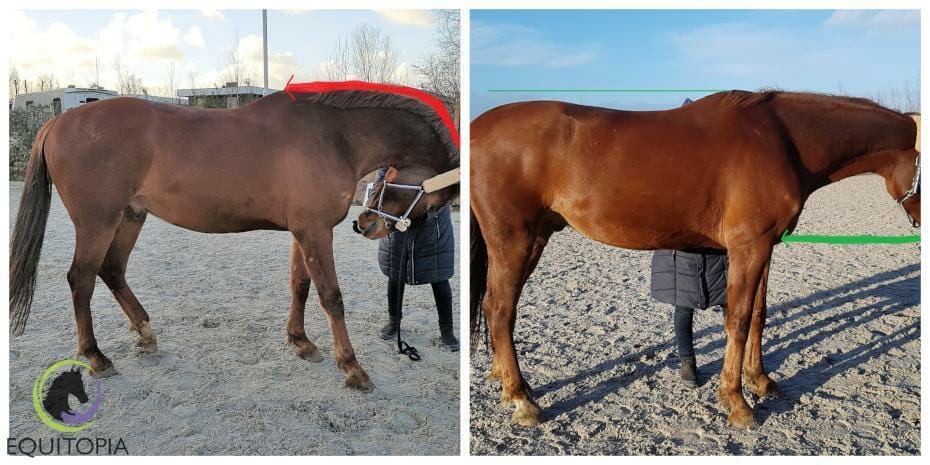MANY TRAINERS ARE TALKING ABOUT LENGTH IN THE NECK, BUT WHAT IS IT EXACTLY?
Let’s start with the opposite of length in the neck. When we train a horse behind the vertical, a little or a lot (LDR), the nose is close to the body of the horse. When we measure the length of the line from the withers to the ears, this length increases but this is not the biomechanical length we need for a correct posture and good movements (Picture below).

Length in the neck means that the nose of the horse is in front of the vertical, far away from the chest of the horse (Picture below). In this case, the entire spine stretches and all the vertebrae can move freely. The topline of the horse lengthens and the underline becomes shorter.
Length in the neck means that the forelegs can go forward – they actually need to go forward because otherwise, the horse would fall on his face. The fore legs need to support the weight of the head, positioned far away from the chest.
If the forelegs go forward the hind legs cannot stay behind. They have to step underneath the body. This way the horse starts to close the underline.

SO WHAT HAPPENS IF WE DECIDE TO SHORTEN THE NECK OF THE HORSE?
- The lower part of the neck (the cervico-thoracic transition or CTT) lowers. The vertebrae of the neck don’t follow the topline of the neck, but form an S-shape. When the neck is shortened the angle in the lower part of the neck becomes sharper. Therefore the horse experiences a lot of pressure and compression in the joints of the lower neck. The movement is blocked. A blockage of the movement somewhere in the spines cause a decrease of movement in the entire spine.
- Lowering of the CTT causes the first part of the thoracic spine to lower. This is the part where the rider is sitting. The horse gets a hollow back. The risk of kissing spines increases.
- The lumbar area of the spine needs to compensate by flexing, which has an effect on the position of the pelvis. This causes lower back pain in the horse and the movement of the lumbar vertebrae is restricted. Therefore the sacroiliac (SI) joints need to compensate and get overloaded.
- If the lower part of the neck including the first thoracic part is sinking, the weight on the forehand increases. This causes overload in the front legs, one of the main causes of suspensory and check ligament injuries.
- Because the underline is too long, the hind legs stay behind the body. This causes overloading of the stifle, the hock and the SI joints.
- And last but not least. The horse naturally uses his head and neck to balance himself like a rope-dancer uses a balance bar. If we shorten the neck we take away the horse’s tool to balance himself. The horse needs to compensate and tightens his muscles. In the long term, his muscles will get stiff and painful and because of this, the horse will get injured quickly. This is due to the lack of stretch in the muscles, the tendons and the fascia when the horse tightens up.
IF YOU FOUND THIS POST INTERESTING, YOU MIGHT BE INTERESTED TO SEE MORE ON THIS TOPIC:
https://www.equitopiacenter.com/courses/chiropractic-care-2/
For more resources, check out the Equitopia membership program – click here




